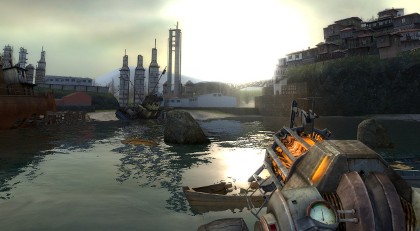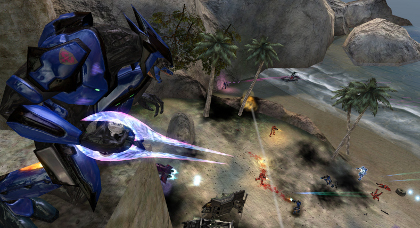Half-Life 2′s release was also interesting as the first major instance of digital distribution. Bellevue-based Valve had struck out on its own after a long – and eventually fractious – association with publisher Sierra, and took the unprecedented step of piping its games direct to consumers via the fledgling Steam delivery system.
Although Valve had road-tested the system with the launch of Counter-Strike: Source, among others, the huge pent-up demand for Half-Life 2 ensured that its arrival was hardly free of technical hitches. This aside, the game’s appearance constituted a bold step towards the future of content delivery – and one which would put Valve in full control of its own destiny, while opening new avenues to publication for like-minded smaller game creators.
But as exciting as the PC scene was at this point, their peers in the living room were also being exceptionally well-served as console development matured. Released in the summer of 2004, Starbreeze’s incredible, genre-straddling The Chronicles of Riddick: Escape From Butcher Bay delivered fantastic entertainment whilst actually rivalling most high-end contemporary PC releases. Sadly, the dismal failure of the Vin Diesel movie ensured the game was roundly ignored at the time.
Not so with Bungie’s Halo 2, which provided Microsoft and the Xbox with its biggest hit to date, and set the standard for online console multiplayer. PS2 owners meanwhile finally got to sample the much-hyped Killzone, also released in November 2004. Although it could never live up to ludicrous expectations, it proved the PS2 could deliver a glorious-looking shooter if Sony put its weight behind the genre.
Nintendo, for its part, had a top-rated first party exclusive in the form of Metroid Prime 2: Echoes. Sadly, despite enthusiastic coverage, sales were poor, as the GameCube’s downward spiral became increasingly obvious.








 Satoru Iwata Video Interview - the late Nintendo president spoke with Kikizo in 2004 as 'Nintendo Revolution' loomed.
Satoru Iwata Video Interview - the late Nintendo president spoke with Kikizo in 2004 as 'Nintendo Revolution' loomed. Kaz Hirai Video Interview - the first of Kikizo's interviews with the man who went on to become global head of Sony.
Kaz Hirai Video Interview - the first of Kikizo's interviews with the man who went on to become global head of Sony. Ed Fries Video Interview - one of Xbox's founders discusses an epic journey from Excel to Xbox.
Ed Fries Video Interview - one of Xbox's founders discusses an epic journey from Excel to Xbox. Yu Suzuki, the Kikizo Interview - we spend time with one of gaming's most revered creators.
Yu Suzuki, the Kikizo Interview - we spend time with one of gaming's most revered creators. Tetris - The Making of an Icon: Alexey Pajitnov and Henk Rogers reveal the fascinating story behind Tetris
Tetris - The Making of an Icon: Alexey Pajitnov and Henk Rogers reveal the fascinating story behind Tetris Rare founders, Chris and Tim Stamper - their only interview? Genuinely 'rare' sit down with founders of the legendary studio.
Rare founders, Chris and Tim Stamper - their only interview? Genuinely 'rare' sit down with founders of the legendary studio. The History of First-Person Shooters - a retrospective, from Maze War to Modern Warfare
The History of First-Person Shooters - a retrospective, from Maze War to Modern Warfare
I want foregathering utile information , this post has got me even more info! .